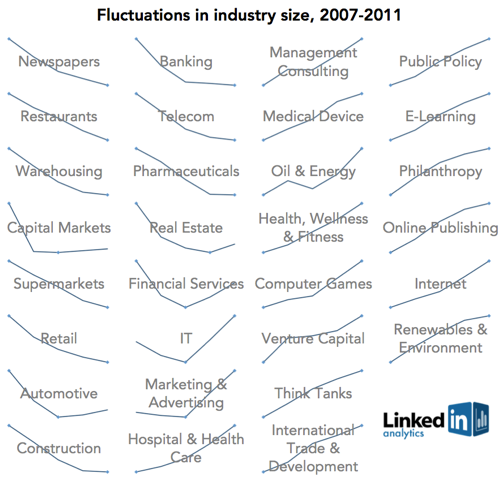LinkedIn Industry Trends: Winners and Losers During the Great Recession
How has our economy evolved in the past five years? Which industries are shrinking or growing through these challenging economic times? These are some of the questions that the Council of Economic Advisors (CEA) delves into each February in the "Economic Report of the President" (ERP). This year, the CEA worked with us to glean further insights into industry trends both during the recent recession and after its end in June 2009 [1]. With the data and methodology [2] in hand, we calculated the growth rates in industry size between 2007 and 2011. Here's what we found:
The fastest-growing industries include renewables (+49.2%), internet (+24.6%), online publishing (+24.3%), and e-learning (+15.9%). Fastest-shrinking industries were newspapers (-28.4%), retail (-15.5%), building materials (-14.2%), and automotive (-12.8%). Instead of the growth in percentage terms, we also examined the volume of job gain / loss by industry, as indicated by the largest bubbles in the figure above. Our data show that even through the recession, the industries with the largest volume of employment growth (the largest circles on the figure above) were internet, hospitals & healthcare, health, wellness & fitness, oil & energy, IT and renewables. On the other side of the story, retail, construction, telecommunications, banking, and automotive had the largest volume of job losses between 2007 and 2011. Some of the most interesting insights came from looking at how the size of industries change as the country enters and emerges from the recession. Below is a figure depicting how industry size fluctuated by year:
In terms of post-recession recovery, IT, marketing & advertising, computer software, and insurance are the largest industries that fell heading towards the end of the recession in 2009 but in 2011 are at or above their 2007 employment level. Financial services is starting its recovery and real estate appears to have bottomed out. Several industries such as newspapers, supermarkets and telecom have continued to shrink throughout the sample period. We were also able to glean the fastest-growing and fastest-shrinking job titles as the Economist noted earlier today. These are fascinating and important data points that allow us to better understand the economic world, and it's just a hint of what we can see by scouring the "data exhaust" of 150+ million LinkedIn members who share information and insights with each other.
It was exciting to be able to work with the CEA on this project, and expect to see more of this from us in the future. Helping people better understand how their skills fit into the broader economic context is something that we are well-suited to do and we would like to provide more of to our members. As our CEO, Jeff Weiner, wrote last autumn, the ability to connect talent with opportunity is more important now than ever before. Our vision is a world where every work opportunity is digitally searchable and linked to the appropriate company and the skills required for that opportunity. These industry trends uncovered by our data science team are steps along the way to making LinkedIn's call for an "economic graph" a reality.
-------
[1] Source: NBER's Business Cycle Dating Committee
[2] We identify industry trends from 2007 through 2011 by longitudinally following anyone in the US who has a position listed in 2007 (we adopted this methodology to control for the incredible growth in our member base since people who join LinkedIn after 2007 still are likely to list a job they had in 2007). This provides us a sample size in the tens of millions.



